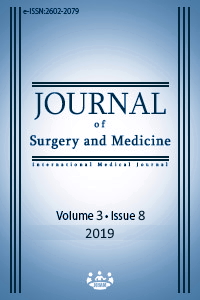The relationship of serum galectin-3 levels with obesity and insulin resistance
Keywords:
Galectin-3, Obesity, Insulin Resistance, Diabetes Mellitus, Metabolic diseaseAbstract
Aim: Galectin-3 affects inflammation, cell adhesion, proliferation, differentiation and angiogenesis. Upon examining the pathogenesis of obesity and functions of galectin-3, we thought that galectin-3 may play a significant role in obese patients. This study aims to evaluate the relationship between obesity, insulin resistance and galectin-3 levels.
Methods: Eighty five patients aged between 18-50 years were included in this cross-sectional study. BMI>30 were considered obese, those between 25-30 and 18-25 were considered overweight and normal weight, respectively. Patients with HOMA-IR>2.5 were considered insulin-resistant, and those with <2.5 were evaluated as insulin non-resistant.Galectin-3 levels were measured by Enzyme-linked immunosorbent assay.
Results: Serum galectin-3 levels were significantly higher in obese patients, but not statistically significantly different between those with and without insulin resistance. Galectin-3 levels were also significantly correlated with BMI and total cholesterol levels, but not correlated with HOMA-IR.
Conclusion: In obesity, serum galectin-3 levels may increase to compensate for the inflammation. Our results make it difficult to establish a relationship between insulin resistance and galectin-3.
Downloads
References
Dumic J, Dabelic S, Flögel M. Galektin-3: an open-ended story. Biochim Biophys Acta. 2006;1760:616–35.
Rasouli N, Kern PA. Adipocytokines and the metabolic complications of obesity. J Clin Endocrinol Metab. 2008;93:64–73.
Kiwaki K, Novak CM, Hsu DK, Liu FT, Levine JA. Galektin-3 stimulates preadipocyte proliferation and is upregulated in growing adipose tissue. Obesity. 2007;15:32–9.
Zeyda M, Farmer D, Todoric J, Aszmann O, Speiser M, Gyori G, et al. Human adipose tissue macrophages are of an anti-inflammatory phenotype but capable of excessive pro-inflammatory mediator production. Int J Obes. 2007;31:1420–8.
Demerath EW, Reed D, Rogers N, Sun SS, Lee M, Choh AC, et al. Visceral adiposity and its anatomical distribution as predictors of the metabolic syndrome and cardiometabolic risk factor levels. Am J Clin Nutr. 2008;88:1263–71.
Martinez-Martinez E, Cachofeiro V, Rousseau E, Alvarez V, Calvier L, Fernandez- Celis A, et al. Interleukin-33/ST2 system attenuates aldosterone-induced adipogenesis and inflammation. Mol Cell Endocrinol. 2015;411:20-7.
Makki K, Froguel P, Wolowczuk I. Adipose tissue in obesity-related inflammation and insulin resistance: cells, cytokines, and chemokines. ISRN Inflamm. 2013;139239.
Weigert J, Neumeier M, Wanninger J, Bauer S, Farkas S, Scherer MN, et al. Serum galektin-3 is elevated in obesity and negatively correlates with glycosylated hemoglobin in type 2 diabetes. J Clin Endocrinol Metab. 2010;95:1404-11.
de Boer RA, van Veldhuisen DJ, Gansevoort RT, Muller Kobold AC, van Gilst WH, Hillege HL, et al. The fibrosis marker galektin-3 and outcome in the general population. J Intern Med. 2012;272:55–64.
Krautbauer S, Eisinger K, Hader Y, Buechler C. Free fatty acids and IL-6 induce adipocyte galectin-3 which is increased in white and brown adipose tissues of obese mice. Cytokine. 2014;69:263–71.
Pang J, Nguyen VT, Rhodes DH, Sullivan ME, Braunschweig C, Fantuzzi G. Relationship of galektin-3 with obesity, IL-6, and CRP in women. J Endocrinol Invest. 2016;12:1435-43.
Buechler C, Wanninger J, Neumeier M. Adiponectin, a key adipokine in obesity related liver diseases. World J Gastroenterol. 2011;17:2801–11.
Jung-Hwan B, Seok-Jun K, HyeokGu K, Hyun-Woo L, Jung-Hoon K, Kyung H, et al. Galektin-3 Activates PPAR_ and Supports White Adipose Tissue Formation and High-Fat Diet-Induced Obesity. Endocrinology.2015;156:147–56.
Rhodes DH, Pini M, Castellanos KJ, Montero-Melendez T, Cooper D, Perretti M,et al. Adipose tissue-specific modulation of galectin expression in lean and obese mice: evidence for regulatory function. Obesity.2013;21:310–9.
Pejnovic NN, Pantic JM, Jovanovic IP, Radosavljevic GD, Djukic A, Arsenijevic NN, et al. Galektin-3 is a regulator of metaflammation in adipose tissue and pancreatic islets. Adipocyte. 2013;2:266–71.
Pang J, Rhodes DH, Pini M, Akasheh RT, Castellanos KJ, Cabay RJ, et al. Increased adiposity, dysregulated glucose metabolism and systemic inflammation in Galektin-3 KO mice. PloS One. 2013;8:e57915.
Pejnovic N, Pantic J, Jovanovic I, Radosavljevic G, Milovanovic M, Nikolic I, et al. Galektin-3 deficiency accelerates high-fat diet induced obesity and amplifies inflammation in adipose tissue and pancreatic islets. Diabetes. 2013;62:1932–44.
Zhu W, Sano H, Nagai R, Fukuhara K, Miyazaki A, Horiuchi S. The role of galectin-3 in endocytosis of advanced glycation end products and modified low density lipoproteins. Biochem Biophys Res Commun. 2001;280:1183–8.
Li P, Liu S, Lu M, Bandyopadhyay G, Oh D, Imamura T, et al. Hematopoietic-derived galektin-3 causes cellular and systemic insulin resistance. Cell. 2016;167:973–84.
Baek JH, Kim SJ, Kang HG, Lee HW, Kim JH, Hwang KA, et al. Galektin-3 activates PPAR and supports white adipose tissue formation and high-fat diet induced obesity. Endocrinology. 2015;156:147–56.
Darrow AL, Shohet RV. Galektin-3 deficiency exacerbates hyperglycemia and the endothelial response to diabetes. Cardiovasc Diabetol. 2015;14:73.
Ohkura T, Fujioka Y, Nakanishi R, Shiochi H, Sumi K, Yamamoto N, et al. Low serum galektin-3 concentrations are associated with insulin resistance in patients with type 2 diabetes mellitus. Diabetol Metab Syndr. 2014;6:106.
Li P, Oh DY, Bandyopadhyay G, Lagakos WS, Talukdar S, Osborn O, et al. LTB4 promotes insulin resistance in obese mice by acting on macrophages, hepatocytes and myocytes. Nat Med. 2015;21:239.
Yilmaz H, Cakmak M, Inan O, Darcin T, Akcay A. Increased levels of galectin‑3 were associated with prediabetes and diabetes: new risk factor? J Endocrinol Invest. 2015;38:527–33.
Karlsen AE, Storling ZM, Sparre T, Larsen MR, Mahmood A, Storling J, et al. Immune-mediated beta-cell destruction in vitro and in vivo—a pivotal role for galektin-3. Biochem Biophys Res Commun. 2006;344:406–15.
Downloads
- 1530 2044
Published
Issue
Section
How to Cite
License
Copyright (c) 2019 Özgür Altun, Okan Dikker, Murat Akarsu, Yücel Arman, Şengül Aydın Yoldemir, Orkide Kutlu, Perihan Özkan Gümüşkaya, Tufan Tükek
This work is licensed under a Creative Commons Attribution-NonCommercial-NoDerivatives 4.0 International License.
















